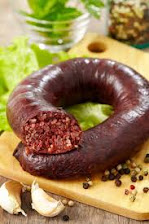Casings for sausage
(For the caliber, the specification Ø is made in mm)
Here is a list especially for the newbies and beginners among the hobby sausage lovers
Pig Casing:
The most common intestines is the pig's small Casing, which is available in the following sizes:
24/26, 26/28, 28/30, 30/32, 32/34, 34/36, 36/40 and 40+
This casing is often used for bratwurst, bockwurst, raw sausage, Mettenden, raw Polish, knackwurst.
Chitterlings Casing, mainly blood and Make liver sausage.
Fat ends are mainly used for cooked, raw and yellow sausage.
Blood sausage and liver sausage are filled into the bladders.
Beef Casing:
Coronal casings are available in the following sizes:
32/35, 35/37, 37/40, 40/43, 43/46, and 46+
it is used to fill blood, liver, meat and meat sausages, as well as the Lyoner sausage.
Middle intestines, it is available in the following sizes:
40/45, 45/50, 50/55, 60/65, 65/70 and 70+, it is used for scalded and cooked sausages, but also for raw sausages.
The beef hips are suitable for large diameters of tongue blood sausage or meat blood sausage or beef stomachs.
Then there are the fat ends, which is where cookt and raw sausage is filled.
Sheep Casing:
The string is most commonly used, it is available in the following sizes:
14/16, 16/18, 18/20, 20/22, 22/24, 24/26, 26/28 and 28+
Saitlinge offer the thinnest and most delicate skin for all sausages.
Mainly used for boiled sausages, such as B. Wiener, Frankfurter or fine
Grilled sausages, such as B. Nuremberg and also for raw sausage, such as. B. Debreziner and Cabanossi.
The butte or the cap is used from the sheep for raw and boiled sausage.
Types of Artificial Casings
Collagen casings: These casings are made from collagen, a protein found in animal skin. They are a popular choice for breakfast sausages, hot dogs, and Italian sausages.
Cellulose casings: These casings are made from cellulose, a plant-based fiber. They are a popular choice for fresh sausages, such as bratwurst and kielbasa.
Plastic casings: These casings are made from plastic. They are a popular choice for large sausages, such as salami and mortadella.
Advantages of Artificial Casings
Consistent: Uniform in size and thickness.
Easy to clean: Require less preparation than natural casings.
Long shelf life: Can be stored for extended periods.
Disadvantages of Artificial Casings
Less permeable: Do not allow the meat to breathe as well as natural casings.
Less authentic flavor: May not impart the same traditional flavor as natural casings.
Applications of Natural and Artificial Casings
The type of sausage casing used depends on the type of sausage being made. Here are some general guidelines:
Natural casings: Typically used for fresh sausages, such as bratwurst, kielbasa, and Italian sausages.
Collagen casings: A versatile choice for a variety of sausages, including breakfast sausages, hot dogs, and fresh sausages.
Cellulose casings: A good choice for fresh sausages, particularly those that are to be cooked in water, such as hot dogs.
Plastic casings: Typically used for large sausages, such as salami and mortadella.
In conclusion, the choice between natural and artificial sausage casings depends on your personal preferences and the type of sausage you are making. Natural casings offer a traditional flavor and a more authentic experience, while artificial casings offer convenience and consistency.




No comments:
Post a Comment